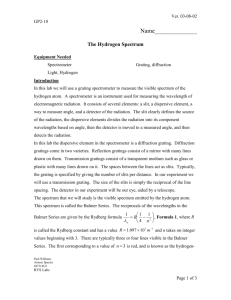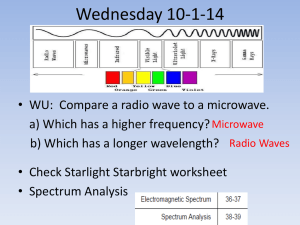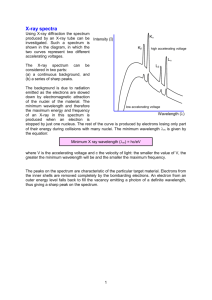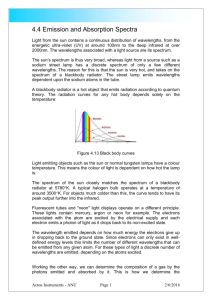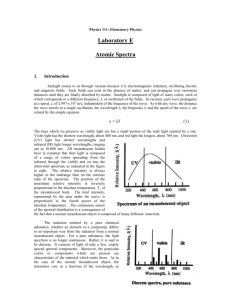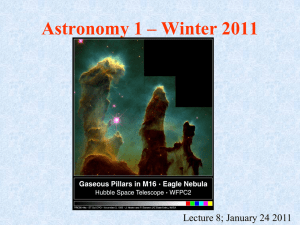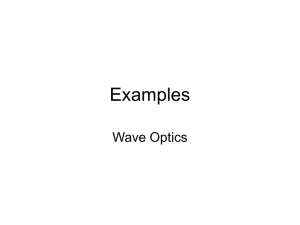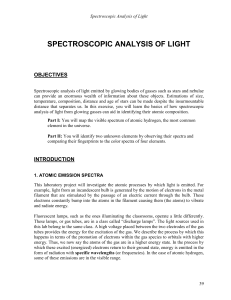The diffraction (bending) of light by a diffraction grating will separate
advertisement
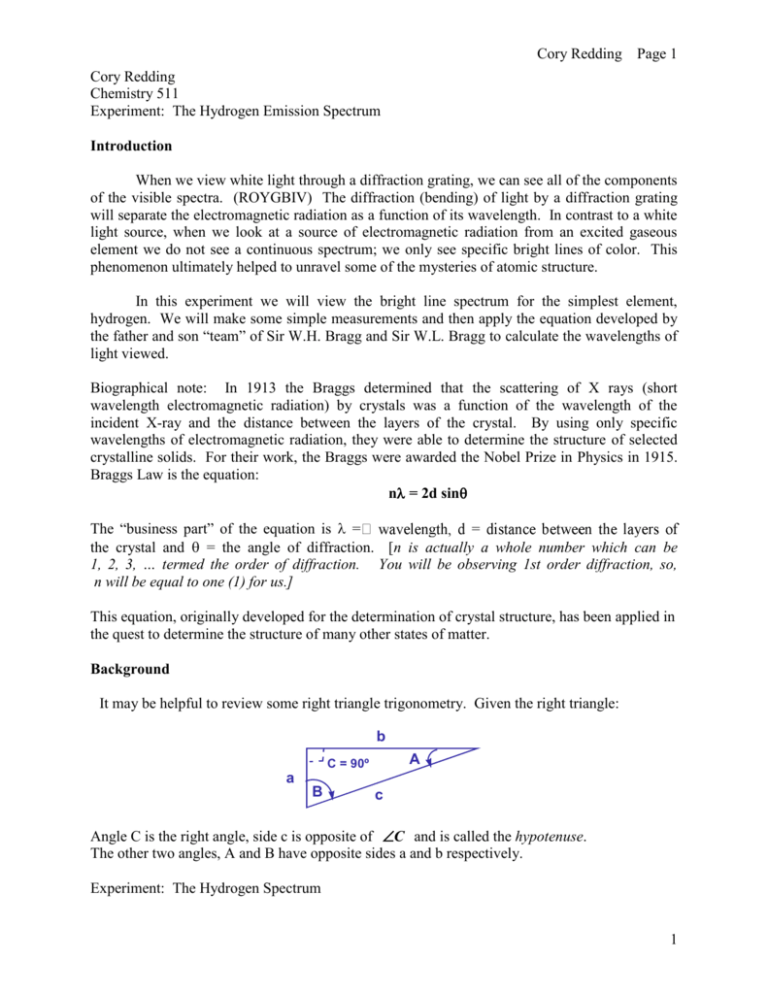
Cory Redding Page 1 Cory Redding Chemistry 511 Experiment: The Hydrogen Emission Spectrum Introduction When we view white light through a diffraction grating, we can see all of the components of the visible spectra. (ROYGBIV) The diffraction (bending) of light by a diffraction grating will separate the electromagnetic radiation as a function of its wavelength. In contrast to a white light source, when we look at a source of electromagnetic radiation from an excited gaseous element we do not see a continuous spectrum; we only see specific bright lines of color. This phenomenon ultimately helped to unravel some of the mysteries of atomic structure. In this experiment we will view the bright line spectrum for the simplest element, hydrogen. We will make some simple measurements and then apply the equation developed by the father and son “team” of Sir W.H. Bragg and Sir W.L. Bragg to calculate the wavelengths of light viewed. Biographical note: In 1913 the Braggs determined that the scattering of X rays (short wavelength electromagnetic radiation) by crystals was a function of the wavelength of the incident X-ray and the distance between the layers of the crystal. By using only specific wavelengths of electromagnetic radiation, they were able to determine the structure of selected crystalline solids. For their work, the Braggs were awarded the Nobel Prize in Physics in 1915. Braggs Law is the equation: n = 2d sin The “business part” of the equation is = the crystal and = the angle of diffraction. [n is actually a whole number which can be 1, 2, 3, … termed the order of diffraction. You will be observing 1st order diffraction, so, n will be equal to one (1) for us.] This equation, originally developed for the determination of crystal structure, has been applied in the quest to determine the structure of many other states of matter. Background It may be helpful to review some right triangle trigonometry. Given the right triangle: b A C = 90º a B c Angle C is the right angle, side c is opposite of C and is called the hypotenuse. The other two angles, A and B have opposite sides a and b respectively. Experiment: The Hydrogen Spectrum 1 Cory Redding Page 2 The following relationships apply: Pythagorean Theorem: a2 + b2 = c2. Sines: sin A = a/c, sin B = b/c. Cosines: cos A = b/c, cos B = a/c. Tangents: tan A = a/b, tan B = b/a. (adapted from http://aleph0.clarku.edu/~djoyce/java/trig/right.html accessed 1/07/06) We can apply the ideas presented above to our experimental design. Power Source Gas Tube Spectral Lines Distance a Distance(s) b Diffraction Grating In this experiment you will look through the diffraction grating to view the hydrogen spectrum produced by the high voltage source and the gas tube. You will measure distance a, the distance from the grating to the source and multiple distances long b, the distance from the source to each spectral line observed. If we look at the measurements that are made, we see that we have a right triangle: b a c 2 Cory Redding Page 3 Experiment: The Hydrogen Spectrum We will adapt Braggs’ Law to allow us to solve for each wavelength of light viewed using the equation: = d sin() Where = the wavelength of light, d = the spacing between the lines of the diffraction grating and = the angle of diffraction. Our next task is to determine how to arrive at sin() from the experimental data. The sine function of an angle is the length of the opposite side divided by the length of the hypotenuse. For angle we know the length of the opposite side (b) but we have not measured the length of the hypotenuse. We do have a measurement for the other side of our right triangle, side a. Applying the Pythagorean Theorem, a2 + b2 = c2 we will be able to compute the length of the hypotenuse and then calculate the sine of the angle. a 2 b2 c2 a 2 b2 c Our working equation to calculate each spectral line observed may be derived. d sin b c b d c sin a2 b2 d b Procedure: 1. The lab will be set up according to the diagram on page 2. 2. In a darkened room, one student will look through the diffraction grating to view the spectral lines of hydrogen. 3. A second student will move a pencil down distance b until the pencil and a spectral line of hydrogen are aligned. This distance will be recorded along with the color of the line observed. 4. This measurement will be repeated for each of line spectral lines observed. 3 Cory Redding Page 4 Experiment: The Hydrogen Spectrum Worked example: a = 35.0 cm ; b = 17.0 cm ; d = 1000 nm a 2 b 2 b d 35 2 17 2 1000 17 = 485.7 nm Other useful formula and constants: c f c 3.00x10 10 cm s E hf c E h h 6.626x10 -34 Js photon Resources: http://www.eserc.stonybrook.edu/ProjectJava/Bragg/ accessed 12/29/05 http://hyperphysics.phy-astr.gsu.edu/hbase/hframe.html accessed 12/29/05 http://aleph0.clarku.edu/~djoyce/java/trig/right.html accessed 1/07/06 http://www.dartmouth.edu/~chemlab/info/resources/mashel/MASHEL.html accessed 12/29/05 4 Cory Redding Page 5 Cory Redding Chemistry 511 The Hydrogen Spectrum Lab Report [Recall that “d” represents the distance between lines in the diffraction grating. If you look at you grating your will read the following listing: “500 lines/mm”, i.e., each millimeter (mm) contains 500 lines. So, the inverse of this, i.e., 1/500 should be the number of millimeters between a line and an adjacent line. Thus, (1/500) mm/line. The result should be: d = 0.002 mm between lines or 2000 nm between lines.] Experimental Data and Calculations: Distance a 90cm 90cm 90cm Distance b Color Observed 20.3cm Purple (violet) 22.4cm Aqua 31.5cm Red Wavelength Energy 440.0 nm 4.512x10-19 483.0nm 4.11x10-19 660.1nm 3.01x10-19 Show representative wavelength and energy calculations. Then fill in the table with you results. Sample calculations (violet/purple): Wavelength = 2000nm ___(20.3)___ √902 + 20.32 = 2000nm ___(20.3)___ √8100 + 412.09 = 2000nm ___(20.3)___ √8512.09 = 2000nm (20.3cm)___ 92.26 = 440nm Energy: Convert from nm to m… (440nm)(1m/1x109)= 4.4x10-7 E=hc/= (6.626x10-34)(3.0x108) = 4.512x10-19 (4.4x10-7) 5 Cory Redding Page 6 1. The energy values calculated represent the energy emitted by the electron when it transitions from higher energy level to a lower. The red line in the hydrogen spectrum is the result of a transition from the n=3 to the n=2 energy levels. What energy level transitions are represented by the other lines in the spectrum? The visible spectrum must always end at 2. Other colors may be represented by energy level transition from higher levels, but always ending at two. For example, orange may be represented by an energy level transition from 4 to 2 and yellow may be represented by an energy level transition from 5 to 2. If electrons were in a higher energy level due to electricity for example, the electron could then make its way back to a lower allowed energy state. That energy loss is negative and seen as visible light. In the lab conducted, purple (violet) would represent an energy level transition between levels 9 and 2 and aqua (blue) would represent an energy level transition between levels 7 and 2. 2. Using your results, explain how ∆E, the difference in energy between levels, varies as n, the energy level, increases. Based on results collected in class, the longer the wavelength, the smaller the energy. Red was the most intense because there are the most 3 to 2 drops. In the case of the blue and the violet, the energy changes get bigger, but by smaller increments so the wavelength becomes shorter. The energy levels are not evenly spaced, but instead “bunched up” as they increase. The red color has a longer wavelength because there a greater energy change between levels three and two. If the ∆E is negative, the electron is transitioning from a higher energy level to a lower energy level. 3. The spectrum you observed is the visible spectrum for hydrogen, also called the Balmer series. There are two other series for hydrogen: the Paschen and the Lyman series. The Pashcen series occurs at wavelengths longer than those observed in the Balmer series while the Lyman series occurs at wavelengths shorter than those observed in the Balmer series. • In which part of the electromagnetic spectrum is each of these spectral series? Please explain your reasoning. Because the levels are not spread out evenly and are more closely bunched at the higher energy levels, there is a smaller drop if the electrons ended at three then there would be if they ended at one (if they started at, for example, 5). The Lyman series occurs at wavelengths shorter than those observed in the Balmer series and therefore most likely ultraviolet. Should you have a transition between levels 2 and 1, where the electron is transitioning from energy level 2 to energy level 1, the energy would be ultraviolet and out of the visible spectrum. This is due to the greater energy change which indicates a shorter wavelength. The Pashcen series occurs at a wavelength longer than those observed in the Balmer series and would therefore be infrared. An example would be a transition where the electron ends at level 3. In this case there is a smaller energy drop resulting in smaller photon energy and a longer wavelength. Recall that the lines in Balmer series can be represented as electron energy level changes (transitions) from n-levels > 2 (i.e., 3, 4, 5, 6, …) down to nf = 2. So, for the Balmer series of lines, some of the electron energy level transitions are: 6 Cory Redding Page 7 ni = 3 ---> nf = 2 ; ni = 4 ---> nf = 2 ; ni = 5 ---> nf = 2 ; etc. One of these “new”spectral series (Paschen or Lyman) involves transitions from higher n-levels to nf =1 and the other involves transitions from higher n-levels to nf = 3. Which electron transitions in the hydrogen atom produce each series? The electron transitions from higher energy levels to energy level 1 represent the Lyman series and the energy transition from higher energy levels to energy level 3 represents the Pachen series. Is this consistent with your answer to #2? Please explain your reasoning. Yes, this is consistent with the answer in number two because there is a greater energy level change between higher levels and level one, resulting in shorter wavelengths. In addition, the energy change is less between higher levels and level three resulting in longer wavelengths. 7
